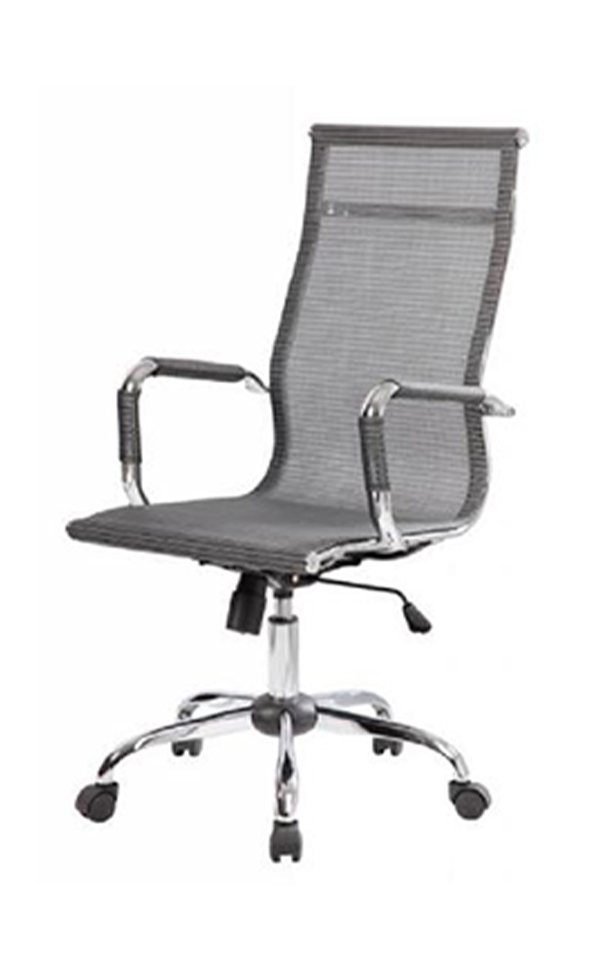The mobility and functionality of a mesh office chair are directly linked to its design, which emphasizes breathability and comfort. Here’s how these aspects perform:
The standout feature of a mesh office chair is its breathable backrest. Unlike leather or foam-padded chairs that can trap heat, the open-weave design of the mesh allows air to circulate freely, which keeps your back cool even during extended periods of sitting. This is especially beneficial in warmer climates or offices without strong air conditioning.
The breathability of the mesh material means that moisture, like sweat, can evaporate quickly. This reduces discomfort from dampness or stickiness, which is common when sitting for long hours in traditional chairs. The chair's breathable nature helps maintain a fresh, dry feeling, promoting better work focus and overall comfort.
The mesh material plays a crucial role in regulating body temperature. When seated in a chair for long periods, body heat tends to accumulate, especially around the back. Mesh chairs allow heat to escape, preventing the uncomfortable buildup of warmth that can cause restlessness and reduced productivity.
This feature is particularly advantageous during the summer or in offices with fluctuating temperatures, as it eliminates the need to adjust your environment to remain comfortable.
Most mesh office chairs come with built-in lumbar support, which is crucial for promoting proper posture and preventing lower back strain. Some models even offer adjustable lumbar support to cater to individual preferences, ensuring that your spine is properly aligned while sitting.
While the backrest is often made entirely of mesh for breathability, the seat is usually cushioned to balance comfort with firmness. High-quality mesh chairs often use memory foam or thick, dense padding to provide the necessary support while maintaining comfort over prolonged periods. The combination of a breathable back and a cushioned seat helps distribute body weight evenly, reducing pressure points and enhancing long-term sitting comfort.
Mesh office chairs are usually equipped with tilt and recline mechanisms that allow users to adjust their sitting posture. Many chairs feature synchro-tilt, meaning the backrest and seat tilt together, providing better ergonomic support. These adjustments ensure that users can recline comfortably without putting undue strain on the lower back or neck.
Beyond lumbar support, mesh chairs often offer customizable settings for seat height, backrest angle, armrest height, and sometimes even the depth of the seat. These features ensure that the chair can be adapted to fit different body types and personal preferences, leading to more tailored comfort.
Unlike fully upholstered chairs, which can feel stifling after long hours, mesh chairs keep you cool and comfortable throughout the day. This reduces fatigue and helps maintain concentration. Over time, traditional chairs with padded backrests may lose their shape and support due to wear, but the mesh in these chairs retains its flexibility and tension, ensuring long-lasting comfort.

For people who experience discomfort in their lower back or pressure on the thighs from sitting in harder chairs, mesh office chairs provide sufficient comfort without causing excessive heat or sweat buildup.
Most mesh office chairs come with cushioned seats to complement the breathable mesh back. These cushions are usually made of high-density foam, memory foam, or other durable padding materials that balance softness with support. This design prevents discomfort from long-term sitting by reducing pressure on the hips and thighs.
While the back provides the breathability, the padded seat ensures you remain comfortable even when sitting for extended periods, as it helps distribute your body weight evenly, reducing pressure points that can lead to discomfort.
The ergonomic design of mesh chairs, particularly with adjustable lumbar support and the naturally flexible mesh back, helps distribute your body weight evenly across the chair. This reduces pressure on specific areas, like your lower back, and ensures good posture throughout the day. The adjustability also means that users of different body shapes and sizes can find the right configuration for comfort.
By allowing movement while seated, mesh chairs promote active sitting, where subtle adjustments and shifts in posture keep your body engaged and prevent stiffness.
Many mesh office chairs come with an adjustable tilt mechanism, allowing users to recline the chair to a comfortable angle. Some have locking positions, meaning you can lock the chair in a specific reclined position, ideal for moments of relaxation or stretching during long work hours.
Adjustable armrests can be moved up, down, or sideways in some models, helping to reduce strain on the shoulders and wrists. Proper armrest positioning contributes significantly to overall comfort, especially for tasks like typing or using a mouse.In some higher-end models, you can adjust the seat depth to accommodate different leg lengths, ensuring your thighs are fully supported while sitting, which enhances circulation and comfort during long sessions.
Mesh office chairs perform exceptionally well in terms of both breathability and comfort. The breathable mesh back keeps users cool by allowing air circulation, preventing heat buildup, and reducing sweat during long periods of sitting. Meanwhile, the ergonomic design—offering lumbar support, adjustable features, and cushioned seats—ensures that the chair remains comfortable and supportive, even during extended use. This combination of breathability and comfort makes mesh office chairs a practical choice for maintaining focus and reducing physical strain in the workplace.


 English
English Español
Español










